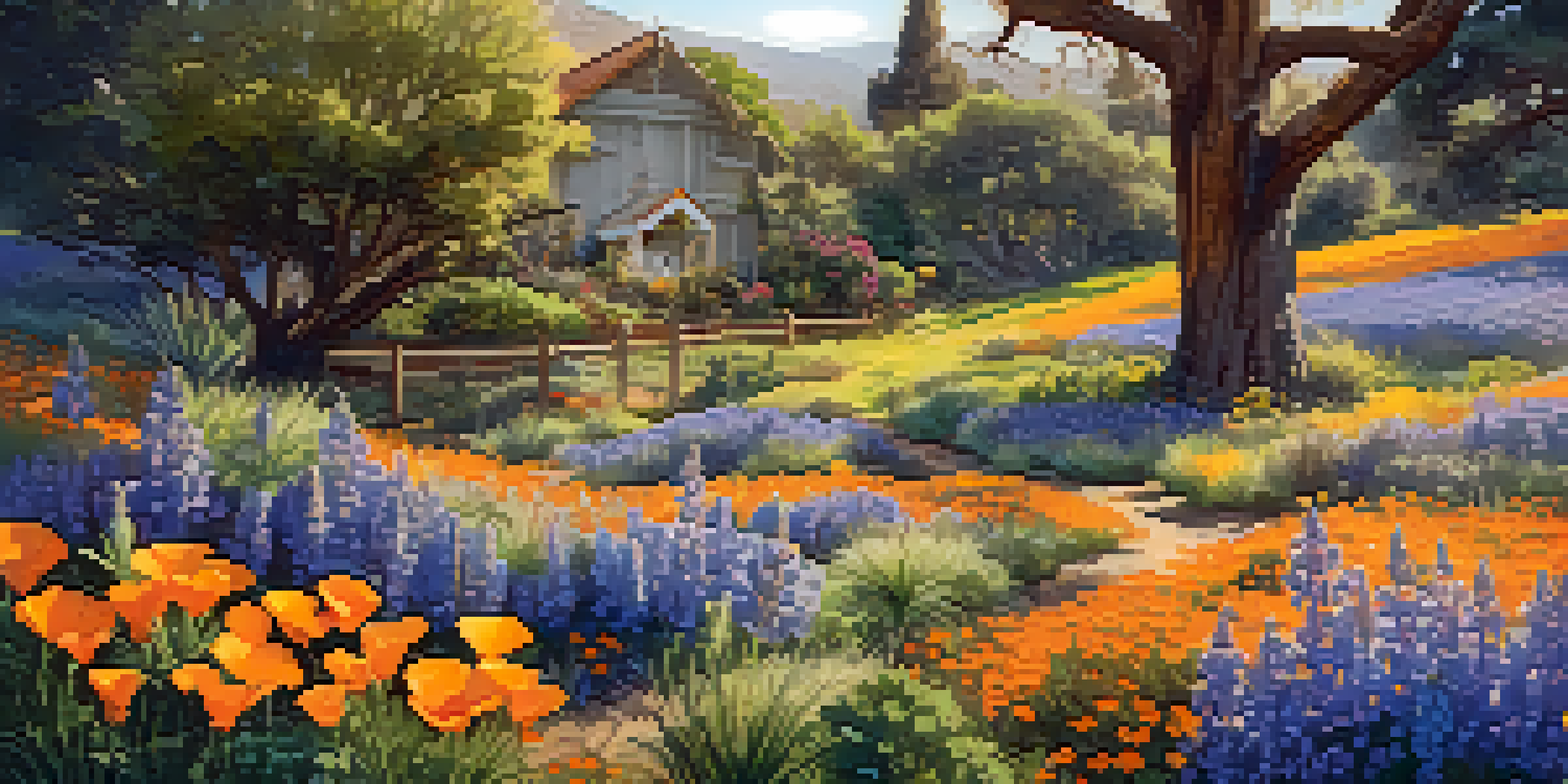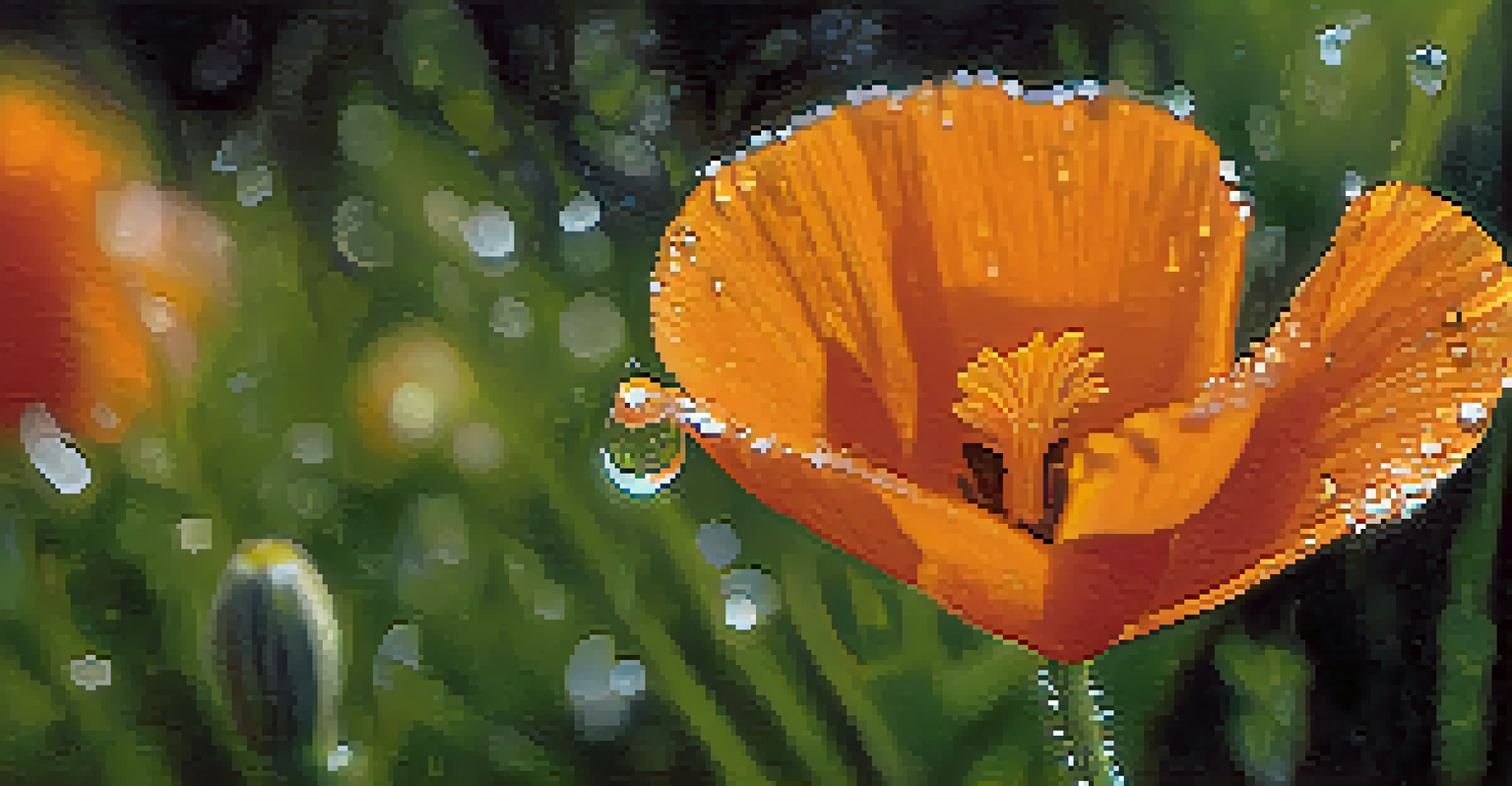The Role of Native Plants in Sacramento Landscape Design

Understanding Native Plants and Their Benefits
Native plants are species that have evolved in a specific region, adapting to the local climate and soil. In Sacramento, these plants are not just beautiful; they are essential for maintaining the ecosystem. They provide habitats for local wildlife, including birds, insects, and small mammals, which helps sustain biodiversity within the urban landscape.
The greatest threat to our planet is the belief that someone else will save it.
By choosing native plants for landscaping, homeowners can create a more resilient garden that requires less water and maintenance. This is particularly important in areas like Sacramento, where water conservation is crucial due to periodic droughts. Native plants often have deep root systems that allow them to thrive with minimal irrigation, making them a practical choice for sustainable landscaping.
Moreover, native plants can enhance the aesthetic appeal of a landscape by showcasing the unique flora of the region. From vibrant wildflowers to sturdy shrubs, these plants offer a rich palette of colors and textures that can transform any garden into a beautiful sanctuary. This not only elevates personal spaces but also contributes to the overall charm of the community.
The Environmental Impact of Native Landscaping
Incorporating native plants into landscape design significantly benefits the environment. These plants support local pollinators, such as bees and butterflies, which are crucial for the health of our ecosystems. By providing food and shelter for these species, we help ensure the continued pollination of crops and wild plants, essential for food production and biodiversity.

Additionally, native plants can improve soil health and prevent erosion. Their deep roots help to stabilize the soil, reducing runoff and allowing rainwater to permeate effectively. This is particularly important in urban areas like Sacramento, where impervious surfaces often contribute to flooding and water quality issues.
Benefits of Native Plants
Native plants are essential for maintaining local ecosystems, providing habitats for wildlife, and requiring less water and maintenance.
By promoting the use of native plants, we also reduce the need for chemical fertilizers and pesticides, which can harm local wildlife and pollute waterways. This holistic approach to landscaping not only fosters a healthier environment but also aligns with the principles of sustainable living.
Choosing the Right Native Plants for Your Landscape
When selecting native plants for your Sacramento garden, it's essential to consider the specific climate and soil conditions of your property. Factors such as sunlight, moisture levels, and soil type will influence which plants will thrive. Researching local plant species that are well-suited to your environment will ensure a successful gardening experience.
Nature does not hurry, yet everything is accomplished.
Some popular native plants in the Sacramento area include California poppies, lupines, and various species of oaks. These plants not only offer visual appeal but also provide habitat and food for local wildlife. Visiting local nurseries that specialize in native plants can be a great way to discover suitable options for your landscape.
Additionally, consider the growth habits and maintenance needs of different native plants. Some may spread quickly and require regular pruning, while others may be more low-maintenance. By understanding these characteristics, you can create a harmonious landscape that reflects your personal style and supports the local ecosystem.
Creating a Wildlife-Friendly Landscape
One of the most rewarding aspects of using native plants in your landscape design is the opportunity to attract and support local wildlife. By incorporating a variety of plants that bloom at different times of the year, you can provide a continuous source of food for birds and insects. This not only enhances the beauty of your garden but also fosters a thriving ecosystem right in your backyard.
Consider adding features like birdhouses, butterfly gardens, and water sources to further encourage wildlife. These elements create a welcoming environment for birds, butterflies, and beneficial insects, enhancing the ecological value of your landscape. The more diverse the habitat, the more species it can support, creating a vibrant community of wildlife.
Economic Advantages of Native Landscaping
Landscaping with native plants can lower water bills and maintenance costs while enhancing property value and curb appeal.
By observing the interactions between plants and wildlife in your garden, you can gain a deeper understanding of the natural world. This connection to nature can be incredibly fulfilling, reminding us of our role in preserving the environment and supporting local ecosystems.
The Economic Benefits of Native Landscaping
While the environmental benefits of native plants are well-known, their economic advantages are often overlooked. Landscaping with native plants can save homeowners money in the long run, as these plants typically require less water and maintenance than non-native species. This translates to lower water bills and reduced costs for gardening services, making native landscaping a smart financial choice.
Moreover, properties that feature native plants can enhance curb appeal and potentially increase property values. Homebuyers are increasingly drawn to eco-friendly features, and a well-designed landscape with native plants can set a home apart in a competitive market. This investment in sustainable landscaping can pay off significantly when it comes time to sell.
Additionally, as cities and communities place greater emphasis on sustainability, there may be grants or incentives available for those who choose native landscaping. By engaging with local environmental initiatives, homeowners can take advantage of these opportunities while contributing to a greener future for Sacramento.
Overcoming Challenges with Native Plant Landscaping
Despite the numerous benefits that native plants offer, some homeowners may face challenges when incorporating them into their landscape. One common issue is the perception that native plants are less attractive or more difficult to manage compared to traditional ornamental plants. However, with the right knowledge and resources, these concerns can be easily addressed.
Educating oneself about the various native plants available and their maintenance needs is essential. Local gardening groups, extension services, and online resources can provide valuable information and support for those looking to adopt native landscaping practices. Connecting with other enthusiasts can also inspire creativity and confidence in designing a beautiful, eco-friendly garden.
Community Support for Sustainability
Local initiatives promote native plant use, fostering community engagement and a collective effort toward environmental sustainability.
Finally, patience is key when establishing a native plant landscape. Many native plants take time to establish, and their beauty may not be immediately apparent. However, with persistence and proper care, these gardens can flourish into stunning displays that celebrate the unique flora of Sacramento.
Embracing Community Initiatives for Native Landscaping
Community initiatives play a vital role in promoting native plant landscaping in Sacramento. Local organizations and agencies often host workshops, plant sales, and educational events focused on the benefits of native plants. By participating in these activities, residents can learn more about sustainable landscaping practices and connect with like-minded individuals.
Moreover, many communities are beginning to implement policies that encourage the use of native plants in public spaces and private gardens. This shift not only beautifies neighborhoods but also fosters a sense of pride in local ecosystems. Working together, residents can create a more unified and environmentally friendly landscape that benefits everyone.

By embracing these community initiatives, homeowners can contribute to a larger movement toward sustainability. Each native plant garden is a step toward preserving the unique natural heritage of Sacramento, making a positive impact on both the environment and the community as a whole.